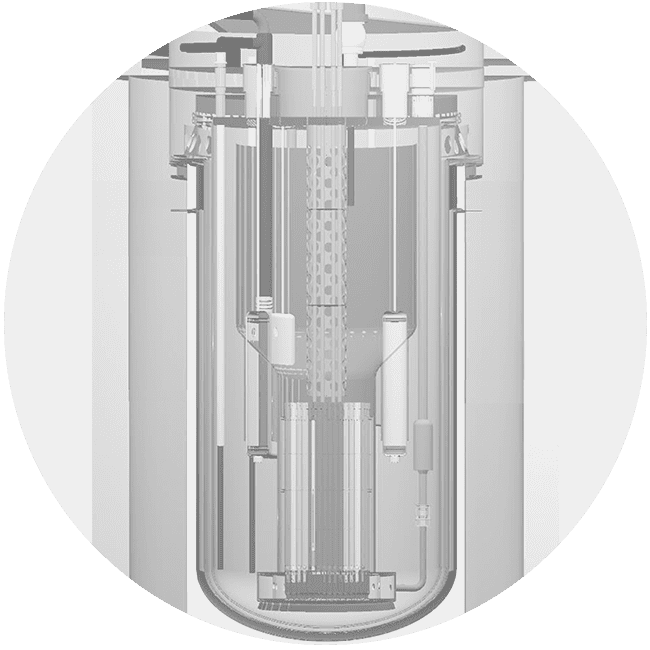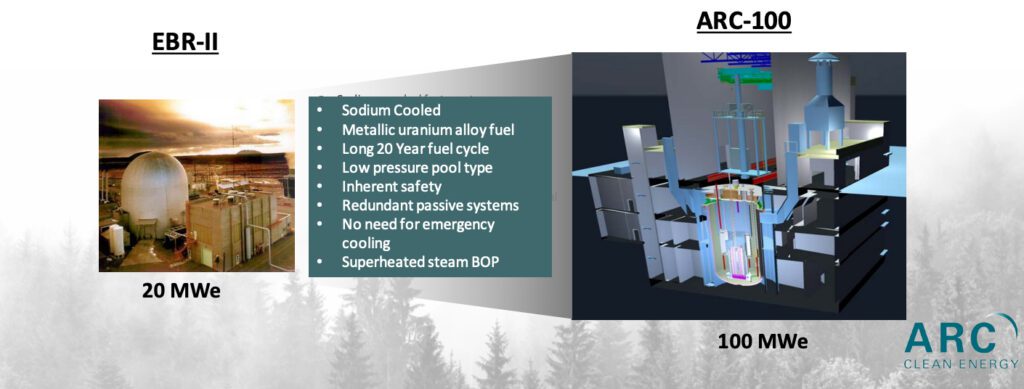Canada’s National Nuclear Lab Backs Fuel Development for ARC Fast Reactor

Canadian Nuclear Laboratories (CNL) and ARC Clean Energy Canada have agreed to collaborate on a two-year joint project to deliver a technology demonstration for the fuel fabrication process" customized for ARC Canada's ARC-100, a 100-MWe/286-MWth, sodium-cooled advanced small modular reactor" (aSMR), the parties announced on July 26.
The development marks a pivotal boost for ARC Canada, which plans to deploy Canada's first commercial grid-scale aSMR at NB Power's Point Lepreau Nuclear Generating Station in New Brunswick within a decade. CNL, Canada's national nuclear laboratory, is meanwhile counting on leveraging experience gleaned from the project to enrich its skillset for supporting the nation's flourishing fleet of aSMRs.
An aSMR Derived from the EBR-IIARC Canada's ARC-100 design is essentially a fast-neutron spectrum reactor that uses a sodium coolant and a metallic uranium-zirconium alloy fuel to allow operation at near-atmospheric pressure while producing high-quality steam for power generation and industrial processes. While small, the ARC-100 design is scalable. The term aSMR" describes small modular reactor (SMR) designs that are not based on existing light water reactor (LWR) technology and that use fuels other than uranium oxide.
The ARC-100 design, notably, derives from the 20-MWe/62.5-MWth Experimental Breeder Reactor II (EBR-II), which operated between 1964 and 1994-and served as Argonne National Laboratory's Integral Fast Reactor (IFR) system prototype between 1982 and 1994. ARC's team, together with world-class technical partners, has refined this underlying technology to create the ARC-100," ARC Clean Energy says.
 ARC Clean Energy says its 100-MWe/286-MWth ARC-100 design is based on demonstrated technology improved for the 21st century." The ARC-100 is a modest scale-up" of the 20-MWe/62.5-MWth EBR-II, which successfully operated from August 1964 to September 1994. Courtesy: ARC Clean Energy
ARC Clean Energy says its 100-MWe/286-MWth ARC-100 design is based on demonstrated technology improved for the 21st century." The ARC-100 is a modest scale-up" of the 20-MWe/62.5-MWth EBR-II, which successfully operated from August 1964 to September 1994. Courtesy: ARC Clean EnergyWhile derived from a technology that is nearly 60 years old, ARC technology is especially well-suited to meet emerging energy challenges, it added. It has a wide range of applications-including grid power, industrial heat, and hydrogen production with true load following," the company said. But the reactor design also consumes its own waste and fuel is recycled over and over, significantly reducing the amount of long-term waste. With a 20-year refueling cycle, systems are immune to short-term supply constraints or political influences," it says.
Fuel development compatible with the reactor technology will be integral to its success, the company acknowledges, however. As part of the agreement unveiled on Tuesday, CNL intends to furnish ARC Canada with expertise in nuclear fuel fabrication and access to its research facilities at Chalk River in Ontario province to develop a fuel pin prototype fabrication line" customized for ARC technology. A key goal for the joint project, which is funded through CNL's Canadian Nuclear Research Initiative (CNRI), is to establish the capability to fabricate the metallic uranium sodium bonded fuel pins using surrogate fuel material," CNL said.
The prototype work will be critical to validate our fuel qualification program and deployment approach," said Dr. Maggie Manley, Fuel Systems Engineer, leading the project for ARC Canada.
CNL noted, however, that the work will also serve as the important groundwork for future initiatives. While the focus for this initial CNRI agreement is on a pilot system, the work will result in a qualified set of procedures for the development of a full production line to support the Canadian fleet," it said.
A Major Project for CNL's SMR VisionThe agreement announced on Tuesday is one of the first unveiled under CNL's 2019-launched CNRI program. The program is dedicated to accelerating the deployment of SMRs in Canada by connecting the SMR industry with research and development facilities and expertise. CNL issued its call for proposals in September 2021 under four focus areas-advanced fuels, advanced materials and chemistry, reactor safety, and component development and testing-and it anticipates program work will wrap up by May 2024. The next call for CNRI proposals is expected to be released in September 2022.
While CNL has not made costs associated with CNRI project development public, it has said its part of cost share ratios associated with the CNRI program will be 50% at most" of the commercial cost of the project.
However, the CNRI program is just one of CNL's SMR initiatives. The national research lab is owned by AECL, a federal Crown corporation that made significant contributions to the design, construction, license, and operation of Canadian-developed nuclear technology, including CANDU reactors. Owing to a federal government-led restructuring of AECL, the lab has since 2015 been operated under contract by private sector consortium Canadian National Energy Alliance (which today comprises three engineering and management firms: Jacobs, Fluor, and SNC-Lavalin).
Since 2019, notably, CNL has set out to become the world's global hub for SMR research and technology." As part of that vision, it wants to build an SMR demonstration unit at a CNL site before 2030. The lab's current focus is a project spearheaded by Global First Power-a joint venture formed by Seattle-based USNC subsidiary USNC-Power and utility Ontario Power Generation (OPG)-which has proposed to build, own, and operate a full-scale 5-MWe/15-MWth MMR reactor at CNL's sprawling 10,000-acre Chalk River Laboratories site in Ontario. The Chalk River MMR is expected to be operational in 2027.
ARC-100 Deployment a Key SMR Stream" for CanadaThe ARC-100 project, meanwhile, has the backing of an interprovincial SMR strategy that has gained steam since it was conceived in 2019. In March 2022, four provinces-New Brunswick, Saskatchewan, Ontario, and Alberta-issued a joint strategic plan outlining a path forward on SMRs. The plan identified three streams" to kick-start SMR development. Stream 1" includes an initial grid-scale 300-MW GE Hitachi BWRX-300 at OPG's Darlington site in Ontario by 2028 and up to four subsequent" units in Saskatchewan, with a first project potentially coming online in 2034. SaskPower on June 28 chose GE Hitachi BWRX-300 for its first two nuclear units, which the provincial utility plans to deploy by the mid-2030s.
Stream 2" includes two advanced designs-ARC-100 and Moltex Energy's Stable Salt Reactor-Wasteburner (SSR-W)-which were selected following a due diligence process conducted by New Brunswick utility NB Power before 2018. Both reactors are proposed for deployment at the Point Lepreau Nuclear Generating Station site. Stream 2 also includes the subsequent potential deployment of multiple units at that site, as well as in other regions of Canada and abroad. Both vendors still need to clear licensing hurdles, however. ARC Clean Energy has begun Phase 2 of the Canadian Nuclear Safety Commission's (CNSC's) pre-licensing Vendor Design Review (VDR) process, while Moltex has completed Phase 1 and is preparing for Phase 2. Stream 3" proposes a new class of micro-SMRs designed primarily to replace diesel use in industrial, remote communities, and other commercial applications.
The interprovincial strategic plan, however, underscores a gap in SMR fuel development. All of the SMR designs under consideration require different forms of fuel that are not currently manufactured in Canada," it notes. For example, they may require low-enriched uranium, fuel salts or reprocessing of used fuel from CANDU or other reactors. In some cases, the fuel can be procured from an existing global supply, some forms of fuel have limited global supply, whereas other forms of fuel are still under development." Still, the plan suggests that deployment of SMRs in Canada represents opportunities for fuel fabrication and other supporting capabilities to be developed across the country."
It adds: Canada has already demonstrated its ability to develop the knowledge and expertise for a robust nuclear fuel supply chain to support the CANDU fleet, and this provides a solid foundation to pursue new technologies. In addition, as Canada gains a more varied nuclear fleet and research reactors, SMRs present many interesting opportunities for fuel recycling and minimizing nuclear waste in the future."
CNL Says It Is Uniquely Qualified' to Manufacture, Test Nuclear Fuel at Chalk RiverAccording to Dr. Jeff Griffin, CNL vice president of Science and Technology, fuel development represents a particular strength" of the CNL's team. "We have supported the fuel development for Canadian heavy water reactor technology since its inception back in the 1950s; we continue to support the fuel needs of low-power and research reactors across Canada and the globe; and in recent years, we have been investing and growing our capabilities in small modular and advanced reactor technologies and fuels," he said. The new CNRI project will enrich the entity's skillset for supporting Canada's SMR ambitions into the future, Griffin added.
However, CNL is already uniquely qualified" to efficiently manufacture and test nuclear fuel at its Chalk River Laboratories site, CNL noted. CNL's Fuel Development Laboratories currently fabricate reactor fuel concepts and prototypes, and evaluate their performance under a variety of simulated reactor conditions, it said.
Both pellet- and pin-type fuel-similar to those used in the ARC Canada technology are fabricated, and CNL is able to further support the work through on-site analytical capabilities including non-destructive examination, metallographic and ceramographic examination, mechanical testing, thermal and physical property measurements, and analytical chemistry," CNL said.
-Sonal Patelis a POWER senior associate editor (@sonalcpatel,@POWERmagazine).
The post Canada's National Nuclear Lab Backs Fuel Development for ARC Fast Reactor appeared first on POWER Magazine.